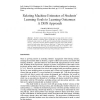483 search results - page 3 / 97 » Learning Relational Sum-Product Networks |
122
Voted
ML
2011
ACM
14 years 7 months ago
2011
ACM
In the last decade, connectionist models have been proposed that can process structured information directly. These methods, which are based on the use of graphs for the representa...
ICONIP
1998
15 years 1 months ago
1998
This paper presents a method to induce relational concepts with neural networks using the inductive logic programming system LINUS. Some first-order inductive learning tasks taken...
AIED
2007
Springer
15 years 6 months ago
2007
Springer
Students’ actions while working with a tuoring system were used to generate estimates of learning goals, specifically, the goal of learning by using multimedia help resources, an...
112
Voted
ICANN
2010
Springer
15 years 1 months ago
2010
Springer
Learning processes allow the central nervous system to learn relationships between stimuli. Even stimuli from different modalities can easily be associated, and these associations ...
83
Voted
ICMI
2007
Springer
15 years 6 months ago
2007
Springer
Automatic distinction between posed and spontaneous expressions is an unsolved problem. Previously cognitive sciences’ studies indicated that the automatic separation of posed f...

